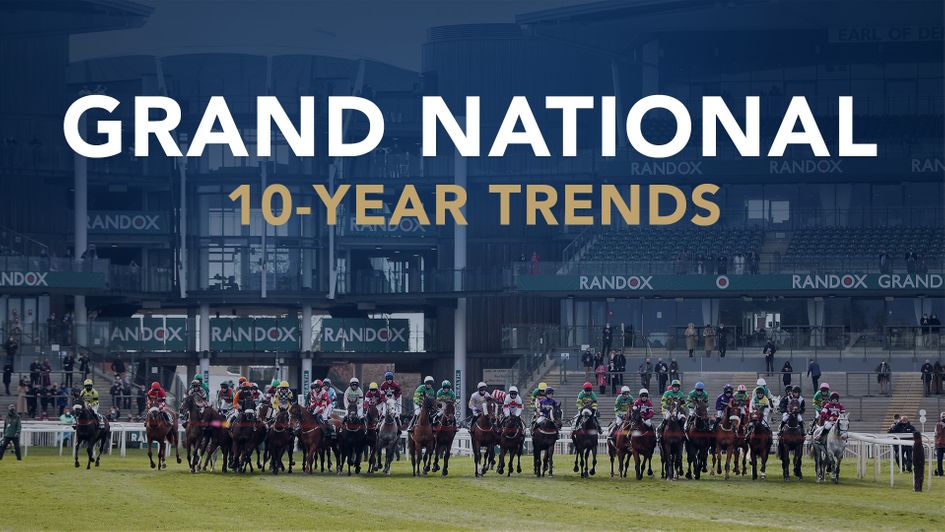Timeform highlight the key trends to consider ahead of Saturday's Randox Grand National at Aintree.
For many once-a-year viewers, names and silks will be their first port of call when trying to identify the 2022 Randox Grand National winner.
If blind luck isn’t your thing however, attempting to make a fact-based selection or selections can be overwhelming. So, what can the past tell us that might help us narrow the field to help?
As opposed to focusing in purely on winners of the race, we’ve looked at all runners in the race since 2013, when the race changed significantly for the better. A reduction in the severity of the fences for safety reasons means the test is far less unique than what it once was, but it still provides a very specific challenge to horse and rider alike.
The course
It is the course and fences itself which first come under the microscope. Using a metric called “Run To Form”, which considers a number of variables including field size and race quality to assess performance relative to the horse, we’ve observed that a lack of a prior run over the National fences doesn’t negatively impact their chances.
However, for those that have run over the course before, those with a positive experience fare significantly better than those who haven’t.
POSITIVES – Prior good course run
NEGATIVES – Have run poorly over the National fences, identified as a poor jumper by Timeform
HORSE TO OPPOSE – Two for Gold
Weight carried and profile
As opposed to many other jump races in the public eye, the Grand National is a handicap meaning, theoretically, the horses are carrying sufficient weight to normalize ability.
This weight is allocated by the official BHA handicapper based on their official ratings (with some minor amendments made for this race as a one off).
Theoretically, therefore when observing a decent sample size we should observe a fairly equal split in performance. However, this hasn’t been the case since 2013. Those carrying within 5 lb of the top weight (marked 1 in the race card) have only run to form 14% of the time, with the rest of the field running to form 21% of the time.
As opposed to this necessarily being down to the actual weight being carried, there are other reasons for this. Although this brief guide to narrowing the field isn’t really geared around putting lines through horses (which can be dangerous for bigger priced fancies), one observation is that horses who have ended up in the race because they are no longer capable of mixing it in the top-level weights races are usually ones to avoid.
The other element is that those carrying more weight have often had more runs and have likely shown the true extent of their ability – often described as being ‘exposed’.
Finally, using independent ratings such as those provided by Timeform can help identify horses who appear to be well treated or not. Those that have fallen into this category in past years have run significantly better than the rest of the field and offer a quick way to narrow the field. Horses not deemed well enough to have a rating, shown little on recent starts are to be avoided, as are those coming in off long breaks.
POSITIVES – Yet to show full ability, running off a fair weight according to Timeform
NEGATIVES – Former graded performers dropping back into handicaps, horses towards the top of the weights, horses who have lost their form
HORSES TO OPPOSE – Delta Work, Minella Times
Early position
Most jockeys will refer to the need to be prominent in the National, to ensure that their horses get a clear sight of the fences and stay out of trouble. The data certainly backs up this view, with those racing in the front half of the field much more likely to give their running than those held up.
However, there is a penalty to be paid for attempting too much from the front. Of the 19 horses who raced in very front rank, only Rathvinden managed to fully see out the race. Forecasting exactly which horses may fall into this trap this year is hard, but narrowing the focus to those who definitely won’t may prove of benefit.
POSITIVES – Those likely to be in the first half of the field
NEGATIVES – Horses leading early, those anchored towards the rear
HORSES TO OPPOSE – Eclair Surf, Run Wild Fred, Mount Ida
Verdict
Rather than now leaving the reader to apply all the above to the field, significant horses of interest who meet most of the above criteria are listed below:
- SNOW LEOPARDESS
- DEATH DUTY
- FORTESCUE
- ESCARIA TEN
- LONGHOUSE POET
- FIDDLERONTHEROOF
For those in search of a final verdict, it could be the traditional variables of trainer, jockey and ground that provide the steer here. Adrian Heskin has three placed finishes over the fences from nine rides and his partner Escaria Ten, trained by Gordon Elliott who is seeking a record equalling fourth National, appears to be the runner with the strongest credentials on trends.
His third in the 2021 National Hunt Chase on similar going is arguably the best piece of form on offer and, granted a large slice of luck, he should be in the frame late on.
More from Sporting Life
- Racecards
- Fast results
- Full results and free video replays
- Horse racing news
- Horse racing tips
- Horse racing features
- Download our free iOS and Android app
- Football and other sports tips
- Podcasts and video content
Safer gambling
We are committed in our support of safer gambling. Recommended bets are advised to over-18s and we strongly encourage readers to wager only what they can afford to lose.
If you are concerned about your gambling, please call the National Gambling Helpline / GamCare on 0808 8020 133.
Further support and information can be found at begambleaware.org and gamblingtherapy.org.












